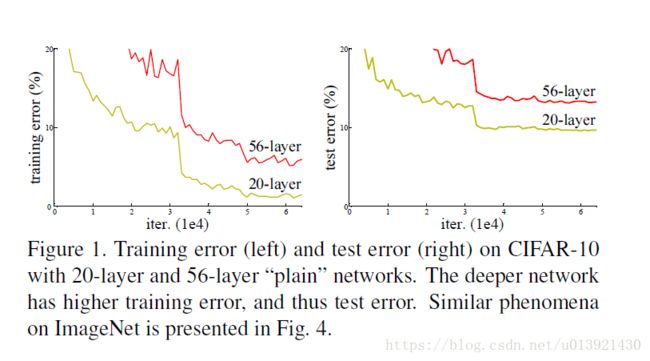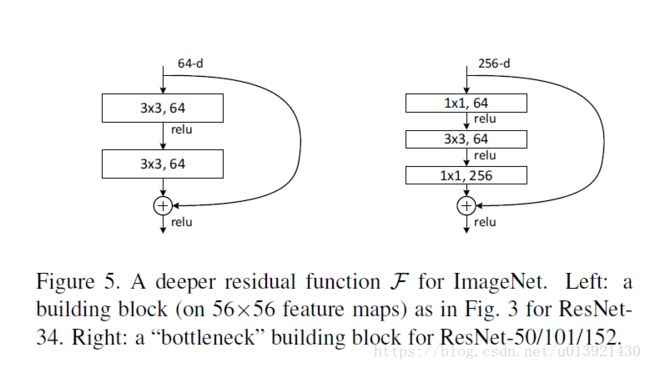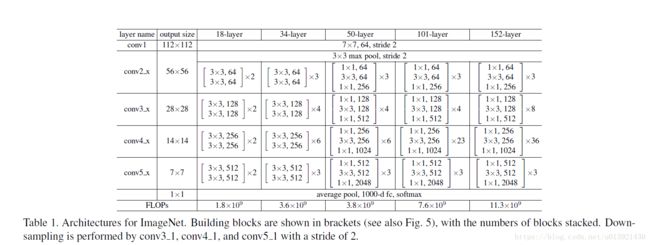【Tensorflow】深度学习实战06——Tensorflow实现ResNet
前言
ResNet(Residual Neural Network)由前微软研究院的 Kaiming He 等4名华人提出(有兴趣的可以点击这里,查看论文原文),通过使用 Residual Blocks 成功训练152层深的神经网络,在 ILSVRC 2015 比赛中获得了冠军,取得 3.57% 的 top-5 错误率,同时参数量却比 VGGNet 低,效果非常突出。ResNet 的结构可以极快地加速超深神经网络的训练,模型的准确率也有非常大的提升。上一篇博文讲解了 Inception,而 Inception V4 则是将 Inception Module 和 ResNet 相结合。可以看到 ResNet 是一个推广性非常好的网络结构,甚至可以直接应用到 Inception Net 中。
网络原理
在ResNet提出之前,瑞士的Schmidhuber教授提出了Highway Network,原理与ResNet相似。Highway Network的目标就是为了解决极深的神经网络难以训练的问题,因为,通常看来神经网络越深其性能越好,但是网络越深其训练难度也就越大。Highway Network相当于修改了每一层的激活函数,此前的激活函数只是对输入做一个线性变换 y=H(x,WH) y = H ( x , W H ) ,Highway Network则允许保留一定比例的原始输入x,即 y=H(x,WH)∗T(x,WT)+x∗C(x,WC) y = H ( x , W H ) ∗ T ( x , W T ) + x ∗ C ( x , W C ) 。其中T为变换稀疏,C为保留系数。这样有一定比例的前一层信息不经过矩阵变换和非线性变换,直接传输到下一层,仿佛一层高速公路,因此命名为Highway Network。几百乃至上千层的Highway Network可以直接使用梯度下降算法训练,并且可以配合多种非线性激活函数,使得学习极深的神经网络也变得可行。Highway Network在理论上是可以训练任意深度的网络的,而传统的神经网络结构则对深度十分敏感。
ResNet与Highway Network相似,也是允许前面的信息直接传递都后面的层中。而ResNet最初的灵感来自于这个问题:随着网络不断地加深,会出现一个Degradation的问题,即准确率会上升然后达到饱和,继续持续增加网络深度会导致准确率下降。如下图所示;
试想,当一个网络已经达到了饱和的准确率,那么再在后面加上几个 y=x y = x 的全等映射层起码不会增加错误。这里提到的全等映射的思想就是ResNet的灵感来源。假设某段网络的输入是 x x ,期望输出是 H(x) H ( x ) ,如果直接把输入作为输出的初始结果,那么此时网络中训练的就是两者之差 F(x)=H(x)−x F ( x ) = H ( x ) − x 。也就是说残差学习网络学习的不再是一个完整的输出,而是输出对输入做差值 F(x) F ( x ) 。下图是VGG-19、直连的34层网络、ResNet的34层结构的对比。
下图为ResNet中两种残差学习单元的结构,其基础结构相近,两层的残差学习单元中包含了两个相同输出同单数的3x3卷积层;3层学习单元则使用了Inception Net中的1x1的卷积层,并且在中间3x3的卷积前后都使用了1x1卷积。需要注意的是,如果在卷积层中改变了Tensor的维度,需要对输入做一个线性的维度变换,保证能够衔接到后层。(在下方代码中,实现这一功能的函数为conv2d_same)
下图是论文中提到的ResNet不同层数时的网络结构。在使用了ResNet的结构后,Degradation的现象被消除了,而且训练误差会随着层数的增大而减小,在测试集上的表现也会变好。在ResNet提出后不久,Google借鉴了ResNet的精髓,提出了Inception V4和Inception-ResNet-V2,通过融合这两个模型,在ILSVRC数据集上取得了惊人的3.08%的错误率。可见,ResNet 及其思想对卷积神经网络研究的贡献确实非常显著,具有很强的推广性。
为什么残差神经网络能有这么好的效果?
上面提到,当网络参数快要达到稳定时,残差学习单元中的shortcut(即跳跃连接)部分的作用显现出来了。它将网络前方的输入直接传递至后方(相当于卷积层的部分对于 H(x) H ( x ) 的贡献相当小了,残差学习单元此时近似于一个恒等函数),保证了网络结构的稳定。如果,残差学习单元中的卷积层部分有学到一些有用的内容,那么残差学习单元的效果恒等函数更好,网络的性能得到了提升。
在训练的时候,残差学习单元中的shortcut是恒等函数,它学习起来非常容易,并不会影响网络训练的效率。
Tensorflow实现网络
根据《Tensorflow 实战》的内容,我实现了一下152层深度的ResNet。代码中有备注,可以供大家参考。
# -*- coding: utf-8 -*-
"""
Created on Tue Jul 3 09:46:34 2018
@author: most_pan
"""
import collections
import time
from datetime import datetime
import math
import tensorflow as tf
slim =tf.contrib.slim
class Block(collections.namedtuple('Block',['scope','unit_fn','args'])):
'A named tuple describing a ResNet block'
#unit_fn是残差学习元生成函数
#args是一个长度等于Block中单元数目的序列,序列中的每个元素
#包含第三层通道数,前两层通道数以及中间层步长(depth, depth_bottleneck, stride)三个量
#在定义一个Block类的对象时,需要提供三个信息,分别是scope,残差学习单元生成函数,以及参数列表
#降采样函数
def subsample(inputs,factor,scope=None):
if factor==1:
return inputs
else:
return slim.max_pool2d(inputs,[1,1],stride=factor,scope=scope)
##用于保证维度一致
def conv2d_same(inputs,num_outputs,kernel_size,stride,scope=None):
if stride==1:
return slim.conv2d(inputs,num_outputs,kernel_size,stride=1,padding='SAME',scope=scope)
else:
pad_total=kernel_size - 1
pad_beg=pad_total // 2
pad_end=pad_total-pad_beg
#使用tf.pad对图像进行填充
inputs = tf.pad(inputs, [[0, 0], [pad_beg, pad_end], [pad_beg, pad_end], [0, 0]])
return slim.conv2d(inputs, num_outputs, kernel_size, stride=stride,
padding='VALID', scope=scope)
@slim.add_arg_scope
def stack_blocks_dense(net,blocks,outputs_collections=None):
for block in blocks:
with tf.variable_scope(block.scope,'block',[net])as sc:
for i,unit in enumerate(block.args):
with tf.variable_scope('unit_%d'%(i+1),values=[net]):
unit_depth,unit_depth_bottleneck,unit_stride=unit #获取每个Block中的参数,包括第三层通道数,前两层通道数以及中间层步长
#unit_fn是Block类的残差神经元生成函数,它按顺序创建残差学习元并进行连接
net=block.unit_fn(net,
depth=unit_depth,
depth_bottleneck=unit_depth_bottleneck,
stride=unit_stride)
net=slim.utils.collect_named_outputs(outputs_collections,sc.name,net)
return net
def resnet_arg_scope(is_training=True,
weight_decay=0.0001,
batch_norm_decay=0.997,
batch_norm_epsilon=1e-5,
batch_norm_scale=True):
batch_norm_params = {
'decay': batch_norm_decay,
'epsilon': batch_norm_epsilon,
'scale': batch_norm_scale,
'updates_collections': tf.GraphKeys.UPDATE_OPS,
'fused': None, # Use fused batch norm if possible.
}
with slim.arg_scope(
[slim.conv2d],
weights_regularizer=slim.l2_regularizer(weight_decay),
weights_initializer=slim.variance_scaling_initializer(),
activation_fn=tf.nn.relu,
normalizer_fn=slim.batch_norm,
normalizer_params=batch_norm_params):
with slim.arg_scope([slim.batch_norm], **batch_norm_params):
with slim.arg_scope([slim.max_pool2d], padding='SAME') as arg_sc:
return arg_sc
#利用add_arg_scope使bottleneck函数能够直接使用slim.arg_scope设置默认参数
@slim.add_arg_scope
def bottleneck(inputs,depth,depth_bottleneck,stride,
outputs_collections=None,scope=None):
with tf.variable_scope(scope,'bottleneck_v2',[inputs])as sc:
#获取输入的通道数目
depth_in=slim.utils.last_dimension(inputs.get_shape(),min_rank=4)
#先对输入进行batch_norm,再进行非线性激活
preact=slim.batch_norm(inputs,activation_fn=tf.nn.relu,scope='preact')
#如果残差神经元的输出通道数目和输入的通道数目相同,那么直接对图像进行降采样,以保证shortcut尺寸和经历三个卷积层后的输出的此存相同
if depth==depth_in:
shortcut=subsample(inputs,stride,'shortcut')
#如果残差神经元的输出通道数目和输入的通道数目不同,利用尺寸为1x1的卷积核对输入进行卷积,使输入通道数相同;
else:
shortcut=slim.conv2d(preact,depth,[1,1],stride=stride,normalizer_fn=None,
activation_fn=None,scope='shortcut')
#然后,定义三个卷积层
residual=slim.conv2d(preact,depth_bottleneck,[1,1],stride=1,scope='conv1')
residual=conv2d_same(residual,depth_bottleneck,3,stride,scope='conv2')
residual=slim.conv2d(residual,depth,[1,1],stride=1,normalizer_fn=None,activation_fn=None,scope='conv3')
#将shortcut和residual相加,作为输出
output=shortcut+residual
return slim.utils.collect_named_outputs(outputs_collections,sc.name,output)
#input是输入,blocks包含残差学习元的参数,num_classes是输出分类数,global_pool是是否进行平均池化的标志位;
def resnet_v2(inputs,
blocks,
num_classes=None,
global_pool=True,
include_root_block=True,
reuse=None,
scope=None):
with tf.variable_scope(scope,'resnet_v2',[inputs],reuse=reuse) as sc:
end_points_collection=sc.original_name_scope+'_end_points'
with slim.arg_scope([slim.conv2d,bottleneck,stack_blocks_dense],
outputs_collections=end_points_collection):
net=inputs
if include_root_block:
with slim.arg_scope([slim.conv2d],activation_fn=None,normalizer_fn=None):
#卷积核为7x7步长为2的卷积层
net=conv2d_same(net,64,7,stride=2,scope='conv1')
#最大值池化
net=slim.max_pool2d(net,[3,3],stride=2,scope='pool1')
#调用stack_blocks_dense堆叠50个残差学习元,每个有三个卷积层
net=stack_blocks_dense(net,blocks)
#先做batch norm然后使用relu激活
net=slim.batch_norm(net,activation_fn=tf.nn.relu,scope='postnorm')
if global_pool: #进行平均池化
net=tf.reduce_mean(net,[1,2],name='pool5',keep_dims=True)
#一个输出为num_classes的卷积层,不进行激活也不归一正则化。
if num_classes is not None:
net=slim.conv2d(net,num_classes,[1,1],activation_fn=None,normalizer_fn=None,scope='logits')
end_points=slim.utils.convert_collection_to_dict(end_points_collection)
#使用softmax进行分类
if num_classes is not None:
end_points['predictions']=slim.softmax(net,scope='predictions')
return net,end_points
#152层残差网络
def resnet_v2_152(inputs,
num_classes=None,
global_pool=True,
reuse=None,
scope='resnet_v2_152'):
blocks=[Block('block1',bottleneck,[(256,64,1)]*2+[(256,64,2)]),
Block('block2',bottleneck,[(512,128,1)]*7+[(512,128,2)]),
Block('block3',bottleneck,[(1024,256,1)]*35+[(1024,256,2)]),
Block('block4',bottleneck,[(2048,512,1)]*3)]
return resnet_v2(inputs,blocks,num_classes,global_pool,
include_root_block=True,reuse=reuse,scope=scope)
#测试性能定义的函数
def time_tensorflow_run(session, target, info_string):
num_steps_burn_in = 10
total_duration = 0.0
total_duration_squared = 0.0
for i in range(num_batches + num_steps_burn_in):
start_time = time.time()
_ = session.run(target)
duration = time.time() - start_time
if i >= num_steps_burn_in:
if not i % 10:
print('%s: step %d, duration = %.3f' %(datetime.now(), i - num_steps_burn_in, duration))
total_duration += duration
total_duration_squared += duration * duration
mn = total_duration / num_batches
vr = total_duration_squared / num_batches - mn * mn
sd = math.sqrt(vr)
print('%s: %s across %d steps, %.3f +/- %.3f sec / batch' %(datetime.now(), info_string, num_batches, mn, sd))
batch_size,height,width=32,224,224
inputs=tf.random_uniform((batch_size,height,width,3))
with slim.arg_scope(resnet_arg_scope(is_training=False)):
net,end_points=resnet_v2_152(inputs,1000)
init=tf.global_variables_initializer()
sess=tf.Session()
sess.run(init)
num_batches=100
time_tensorflow_run(sess,net,"ForWard")
代码分析
上面代码中,resnet_v2_152函数用于设置网络中的参数,它主要是生成了一个变量blocks,并传递给resnet_v2函数。blocks是一个数组,每个元素都是一个Block类对象,每个对象有三个属性,分别是scope,残差学习单元生成函数bottleneck,以及残差学习单元的参数列表。bottleneck根据列表中的内容生成残差学习单元。其它函数的说明在代码中都有标注,大家可以自行理解。
运行结果
已完。。
参考书籍
《Tensorflow 实战》黄文坚等著;




